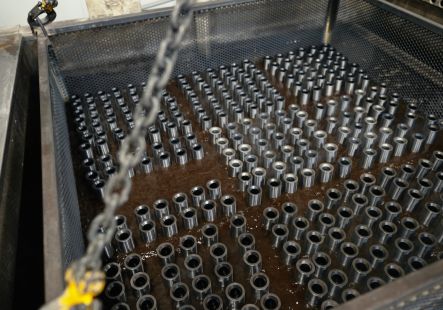Process
Phosphating (also phosphatization) is a chemical process in which coatings are generated on a pure metal (normally steel) surface. Coatings generated by phosphating are electrically non-conductive and therefore reduce the corrosion current value. The coatings bond well with the base metal and are not water- or chemically soluble.
Crystalline phosphate layers generated by phosphatization on surfaces are capable of performing several important functions:
- providing good corrosion protection of metal parts
- improving lubricant adherence to the surface and reducing friction during the formation of steel parts, e.g. before pipe drawing
- improving painting material bond to surface before painting and preventing sub-coat rusting
- reducing friction – used for treating moving steel machine parts for trial runs
- serving as electric isolators
Phosphating as corrosion protection
Phosphating in combination with impregnation is used to protect mass-produced machine parts against corrosion. In addition, the crystalline character of phosphate layers allows for more impregnation material to bond to surfaces. The amount of the bonded impregnation material grows with the thickness of the phosphate layer. The final operation is phosphate layer impregnation with oil, grease or wax.
Phosphating before cold metal formation
Phosphate layers combined with appropriate lubricants act as intermediate layers to reduce friction between the tool and the formed part. When submerged into a hot soap solution, the phosphate layer converts into a layer with the required lubrication properties by absorbing the parts with phosphate layer must be submersed into a hot soap solution to support the conversion of the phosphate layer into a layer with the required lubrication properties. The phosphate layer absorbs soap and the reaction results in the generation of a dissoluble zinc soap.
Phosphating as a surface treatment for paint application
Phosphate layers prevent sub-paint layer rusting and improve the paint bond to the metal surface, resulting in an improved corrosion resistance of painted phosphate surface.
In terms of corrosion protection, the application of a thick phosphate layer would be the most effective. Such layers, however, result in a loss of individual crystals, resulting in paint splitting. The phosphate layer thickness should therefore be kept as low as possible.
Phosphating of moving parts before trial runs
This technology is designed for phosphating the moving parts of machines in order to facilitate the trial run process. The main component of the phosphating agent is manganese; it forms a manganese phosphate layer on the steel surface which, in comparison to standard zinc bearing phosphate layers, has better hardness as well as a higher oil absorption capacity due to the different crystalline structure. The phosphate layer allows for a shorter trial run duration and reduces the wear of parts and motor noise emissions.
We use the following phosphating lines with counter-flow rinsing:
- Mn-Ph Manganese phosphating line
- Zn-Ph Zinc phosphating line
Phosphating is carried out in compliance with EN 12476 and ISO 9717, referring to the structure of fine- to medium-grained manganese phosphate coatings.
The maximum dimensions of parts for phosphating are 1.5m x 1.5m x 1.7m (width/width/height) and maximum weight of parts is 5,000 kg.




